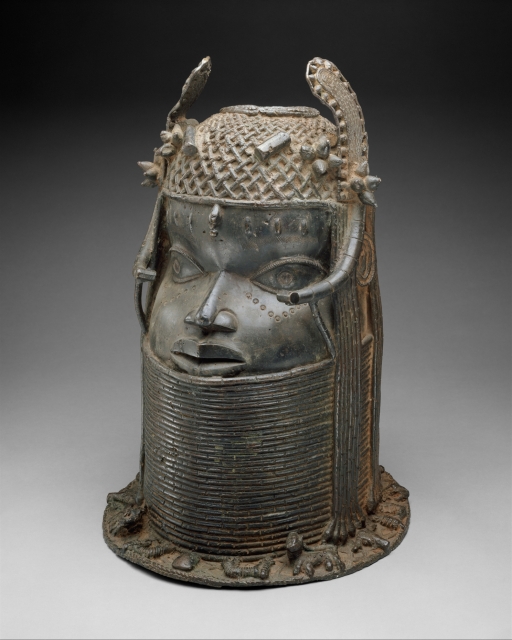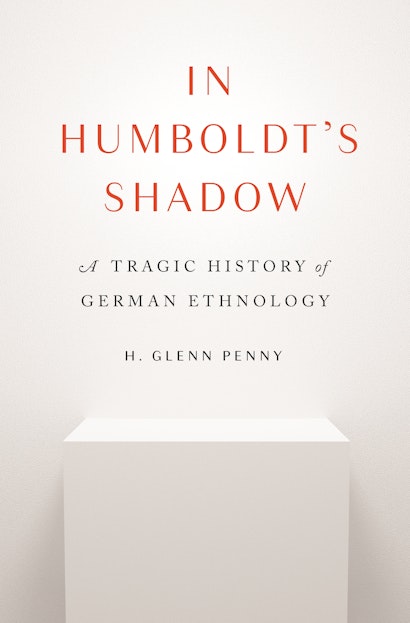Germany’s heated repatriation debates reached a milestone in April 2021. As public discussions became particularly intense over the preceding five years, they focused largely on the opening of the Humboldt Forum, a new exhibition venue in the heart of Berlin. Activists, academics, and pundits not only underscored the connections between Germany’s colonial past and some of the ethnological collections that would be displayed in the edifice named after the brothers Alexander and Wilhelm von Humboldt, they argued that the exhibition plans alone exemplified Germans’ unwillingness to come to terms with that past. They also demanded an accounting.
As the debates raged, the Benin bronzes emerged as a leitmotif in the European press. Their seizure by colonial troops during an 1897 punitive expedition to the Kingdom of Benin (Edo State, Nigeria) exemplified the violence that many argued had helped to fill Europe’s ethnological museums during the age of empire. Those arguments had a notable success. In response, Monika Grütters, the German Minister of Culture, brought together the directors of German museums housing Benin collections, the Cultural Ministers from the German states in which they are located, and members of the German Foreign Office. In April, they worked together with representatives of the Nigerian government toward the return of these objects to Nigeria, and they committed to fashioning a concrete plan that would begin the repatriation process in 2022, when the first warehouse building for the planned Edo Museum of West African Art in Benin City is completed. In addition, the governments of German states and the Federal Republic of Germany are currently financing an on-line platform, Digital Benin (https://digital-benin.org), to transparently display all the artifacts and the extant information about them.
In many ways, however, those notable successes and the debates preceding them have obscured the importance of the millions of other objects housed in Germany’s ethnological museums and the human histories that informed their production. British rather than German colonial troops seized over 3,000 bronze objects during their 1897 punitive expedition to the Royal Palace in the Kingdom of Benin. Despite that, about 1,100 of them found their way into German museums, and some 440 are currently in the Berlin Ethnological Museum. In part, that is because the British soldiers had no idea what they were taking from the Royal Palace they overran. Initially, they treated the bronze figures and plaques only as war booty. Soldiers quickly sold them to traders and dealers in antiquities, some even before they left Africa. Many more were auctioned off in Great Britain. Soldiers and their officers sought personal profits; the British government used the sales to offset the expedition’s costs.
The prices rose precipitously, however, as the world became aware of what was for sale. German ethnologists, in particular, quickly understood the singularity of these objects, identifying their importance for African and world arts, history, and science. Felix von Luschan, who was in charge of the African and Oceanic collections in Berlin’s Museum für Völkerkunde (now the Berlin Ethnological Museum) played a leading role in this process. He swiftly realized that these were unique examples of African art, which not only demonstrated the highest possible technical skills among the Africans who created these objects but also contained extensive information about the history and culture of Benin, including its long interactions with Europeans. As a result, he set himself the task of saving as many of these objects as possible by helping to organize their acquisition by German and non-German museums. Afterwards, he devoted himself to studying all of the extant objects systematically, penning a lavishly illustrated treatise: The Antiquities of Benin (1919). In that text, he argued that their mere existence undermined the racial theories on which British colonialism and European imperialism depended. He made that argument despite the fact that he was a convinced imperialist.
The Berlin Ethnological Museum, however, contains much more than “antiquities” from Benin. It holds well over half a million objects from around the world, much of which has never been put on display. It’s hard not to wonder why the collections are so vast. What on earth were people like Luschan thinking as they built them? What did they mean to do with them? Perhaps most importantly: what should be done with them now?
The objects in the Berlin and other German ethnological museums are so many, so varied, and so uniquely important. These museums, in fact, are treasure troves. The objects that fill them are historical texts, produced by a vast array of cultures, many of which left no written records. They are, in short, key historical sources, and in some cases the only sources, of the human histories that fashioned them.
Few of these objects are as sensational as the Benin bronzes. Yet as Luschan, his mentor Adolf Bastian, and their counterparts taught us, that makes them no less important. Even the most mundane of these objects, like the Hawaiian fishing hooks, nets, and weights collected by Eduard Arning in the 1880s, which are also in the Berlin Ethnological Museum, contain a great deal of information about the people who produced them—about their cultures, their societies, and their world views.
That is why ethnologists like Bastian and Luschan collected them in the first place. They knew that taken together, such objects, and the specific human histories hidden within them, have a great deal to tell us about the history of humanity as a whole—if we are willing to harness the time and resources to engage them. If we would be willing to give them all the kinds of attention that has been lavished on the Benin bronzes, they could teach us a great deal about the multiplicity of human histories and the world views that shaped our past and present.
Until now, such attention was only directed at a fraction of the collections. In part, that is because the speed of acquisitions during the decades leading up to World War I far outpaced German ethnologists’ abilities to work with them. It quickly overwhelmed even the museums’ abilities to house them, much less to put them on display. As a result, many of the collections went directly into storage, where they languished for decades; some remained there for most of a century. Consequently, their histories have remained largely hidden.
We now have the opportunity to free those objects and allow them to teach us to see glimpses of the past. To reactivate them, however, our priorities have to change: funding has to be redirected away from edifices like the Humboldt Forum, which are meant to act primarily as municipal displays—statements of local and national self-aggrandizement—and toward re-staffing these museum with experienced, motivated curators, supporting basic research with the collections, reconnecting that research to the universities, and funding working relations with indigenous groups that are willing, like the Nigerians engaged in dialogs with the Germans, to build working relationships. German ethnologists of the past left that task for future generations. Now is the time to pursue it in earnest.
H. Glenn Penny is professor of modern European history at the University of Iowa. He is the author of Kindred by Choice: Germans and American Indians since 1800 and Objects of Culture: Ethnology and Ethnographic Museums in Imperial Germany.

